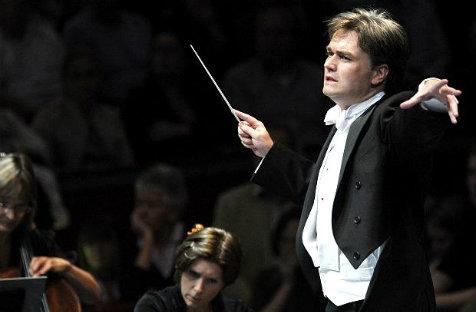When the Melbourne Symphony Orchestra is joined by its Chorus, there’s always the risk that one will be overshadowed by the performance of the other. Or at least that one will be given more space in the review.
The MSO cleverly established its credentials (which were, of course, never in doubt) by beginning with two contrasting works. First was the
Prelude to The Mastersingers of Nuremberg by Wagner. It was, inevitably, a great showcase for the wonderful brass of the orchestra – but the other sections were not to be outdone, in the complex development of the well-known theme.
Visiting conductor Edward Gardner not only looked the part but delivered on the promise, keeping the sound balanced until cymbals heralded the great climax of the work.
Gardner next took to the podium ahead of the performers to explain the reason for the almost complete reconfiguration of the stage that took place between the Wagner and the next work: Bartok’s Music for Strings, Percussion and Celeste. There would effectively be two orchestras, he said, one on either side of the conductor (leading to the interesting situation of having third and fourth violins, as well as the usual first and second).
This arrangement allowed the composer to create a stereo-type effect at times, while at others setting the two main groups against each other to deliver a more asymmetric sound – at times like a vivid dance, at others like jousting, Gardner said.
This surely must have presented the conductor with a unique task, especially as the moods of the four movements were so volatile. The work began in a sombre fashion, with one ‘orchestra’ more occupied with a fugue than the other and the celeste lending an unearthly sound. The second movement was all frenetic energy, with added verve from piano and timpani, and an extraordinary pizzicato effect from the strings.
After a somewhat ominous-sounding Andante, the final movement was in recognisable Bartok style, with folk melodies and shifting rhythms. But there was plenty of syncopation too, as the two orchestral groups played from two apparently quite different scores. The piano (brilliantly played by baroque specialist Donald Nicolson leaping a few centuries ahead) led a jazz-inspired section and, near the end, what seemed like a concerto, before the work came to an abrupt end.
The performance was a tour de force for conductor and players, evoking a sense of pride that this was Melbourne’s own orchestra. This was easily extended to embrace the Melbourne Symphony Orchestra Chorus, which joined the orchestra after interval for the work that gave the concert its name: Mozart’s Requiem Mass, K626.
Much has been written about the work, most of it apocryphal, but instead (and for a reason) I offer my own short story.
Some years ago, in the depths of a Viennese winter, I heard Mozart’s Requiem in a beautiful baroque church. It was free, and it soon became apparent why: mourners in black filed in silently, followed by priests in vestments, as the smell of incense filled the dimly-lit space. The performance was part of an actual requiem mass and it was to be the one that I would judge all others by.
So how did this Melbourne performance (in a beautiful modern concert hall, on a steamy summer night) measure up? Of course the performance was superior, with a professional orchestra and chorus, and four fine soloists, heard at best in the quartet Recordare once balance was achieved.
Mention must be made of soprano Elena Xanthoudakis who is enjoying operatic success internationally, but whose voice was also beautifully suited to this Mozart work.
From the opening Kyrie to the last great fugue, Cum sanctus, the choir thrilled with its mastery of long, difficult polyphonic phrases, and achieved the volume needed to match the power of the words. This was partly thanks to the strong contingent of male voices but also to the clarity and precision of all four parts. There were contrasts in dynamics, and a happy partnership with the orchestra – no mean feat, with each chorus presenting a unique challenge.
There was also sweetness and reverence in sections such as Lacrimosa. If I have one criticism it is that there needed to be more of a hush and sense of awe, to balance those powerful choruses that were so well executed. It was overwhelmingly present that wintry night in Vienna – but perhaps that’s an unfair comparison.
As a concert piece the Requiem certainly lived up to the high standards set in the first part of the program.
Rating: 4 stars out of 5
Mozart’s Requiem
Melbourne Symphony Orchestra
Melbourne Symphony Orchestra Chorus
Edward Gardner – conductor
Elena Xanthoudakis – soprano
Sally-Anne Russell – mezzo-soprano
Andrew Staples – tenor
Matthew Rose – bass
WAGNER: The Mastersingers of Nuremberg: Prelude
BARTOK: Music for Strings, Percussion and Celeste
MOZART: Requiem (completed Süssmayr)
Hamer Hall, Melbourne
7 March





